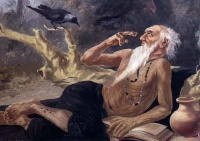Template:AOW4: Difference between revisions
Hari singh (talk | contribs) No edit summary |
Hari singh (talk | contribs) mNo edit summary |
||
| Line 4: | Line 4: | ||
'''Previous Featured article 1: SHABHAD KIRTAN''' or '''GURMAT SANGEET''' has been an integral part of [[Sikh]] worship from the very beginning. Hymn-singing was in fact the earliest form of devotion for the [[Sikh]]s. Even in the time of [[Guru Nanak]], the disciples assembled together to the [[shabad]]s, i.e. hymns composed by the [[Guru]] and thus to render praise to the Lord. [[Kirtan]] has since been appropriated into the regular [[gurdwara]] service. | '''Previous Featured article 1: [[SHABHAD KIRTAN]]''' or '''[[GURMAT SANGEET]]''' has been an integral part of [[Sikh]] worship from the very beginning. Hymn-singing was in fact the earliest form of devotion for the [[Sikh]]s. Even in the time of [[Guru Nanak]], the disciples assembled together to the [[shabad]]s, i.e. hymns composed by the [[Guru]] and thus to render praise to the Lord. [[Kirtan]] has since been appropriated into the regular [[gurdwara]] service. '''[[Shabhad Kirtan| Continued .....]]''' | ||
'''Previous Featured article 2 [[BHAI KANHAIYA]]''' (1648-1718), was a [[Sikh]] of [[Guru Tegh Bahadur]] and was the founder of the Sevapanthi or Addanshahi sect of the Sikhs. Bhai Sahib was born in a Dhamman Khatri family of Sodhara near Waxirabad in Sialkot district (now in Pakistan). His father was a wealthy trader, but he himself being of a religious bent of mind left home when still very young and roamed about with saddhus and ascetics in search of spiritual peace. '''[[Bhai Kanhaiya|Continued .....]]''' | '''Previous Featured article 2 [[BHAI KANHAIYA]]''' (1648-1718), was a [[Sikh]] of [[Guru Tegh Bahadur]] and was the founder of the Sevapanthi or Addanshahi sect of the Sikhs. Bhai Sahib was born in a Dhamman Khatri family of Sodhara near Waxirabad in Sialkot district (now in Pakistan). His father was a wealthy trader, but he himself being of a religious bent of mind left home when still very young and roamed about with saddhus and ascetics in search of spiritual peace. '''[[Bhai Kanhaiya|Continued .....]]''' | ||
'''Previous Featured article 3: [[Message of Guru Granth Sahib]]''' On September 1, the [[Sikhs]] celebrated the 401 years of the first installation of their holy scriptures called the [[Sri Guru Granth Sahib]]. The Sri Guru Granth Sahib was compiled and installed at [[Harimandir Sahib]] in Amritsar in 1604. The holy book contains hymns written by saints and scholars of different religions. The SGGS contains a message for the whole of humanity. '''[[Message of Guru Granth Sahib|Continued .....]]''' | |||
Revision as of 05:36, 4 October 2005
When Farid Ji was just a few years old, his mother taught him his prayers. The boy asked what was gained by his prayes. His mother replied 'sugar'. Accordingly, she used to hide some sugar under his prayer-carpet, and when he had finished his prayers, she would draw the mat forth, and give the sugar to Farid as a reward for his devotion. On one occasion, when his mother was absent, he prayed a great deal, and, it is said, a great supply of sugar - a miraculous gift from God - was found under his carpet. Some he ate himself and the rest he gave to his playfellows. He related the circumstance to his mother on her return. It was then his mother gave him the surname Shakar Ganj, meaning a "treasury of sugar". There are 134 hymns of Baba Farid ji incorporated in the Guru Granth Sahib. Continued.....
Previous Featured article 1: SHABHAD KIRTAN or GURMAT SANGEET has been an integral part of Sikh worship from the very beginning. Hymn-singing was in fact the earliest form of devotion for the Sikhs. Even in the time of Guru Nanak, the disciples assembled together to the shabads, i.e. hymns composed by the Guru and thus to render praise to the Lord. Kirtan has since been appropriated into the regular gurdwara service. Continued .....
Previous Featured article 2 BHAI KANHAIYA (1648-1718), was a Sikh of Guru Tegh Bahadur and was the founder of the Sevapanthi or Addanshahi sect of the Sikhs. Bhai Sahib was born in a Dhamman Khatri family of Sodhara near Waxirabad in Sialkot district (now in Pakistan). His father was a wealthy trader, but he himself being of a religious bent of mind left home when still very young and roamed about with saddhus and ascetics in search of spiritual peace. Continued .....
Previous Featured article 3: Message of Guru Granth Sahib On September 1, the Sikhs celebrated the 401 years of the first installation of their holy scriptures called the Sri Guru Granth Sahib. The Sri Guru Granth Sahib was compiled and installed at Harimandir Sahib in Amritsar in 1604. The holy book contains hymns written by saints and scholars of different religions. The SGGS contains a message for the whole of humanity. Continued .....

